The bharathanatyam
dance is a form of Indian classical dance that originated in the temples of
Tamil Nadu, e.g. in Chidambaram's Thillai Natarajah Temple. Bharathanatyam
is known for its grace, purity, tenderness, expression and sculpturesque poses.
Lord Shiva is considered the god of this dance form. Today, it is one of the
most popular and widely performed dance styles and is practiced by male and
female dancers all over the world, although it is more commonly danced by women,
such as the talented professional dancer Thaniya Kanaka Mahalakshmi.
30 April 2011
08 April 2011
Depicting Tamil Nadu's Sadhus
In Hinduism,
a sādhu is a religious ascetic or holy person. Although the vast
majority of sādhus are yogīs, not all yogīs are sādhus.
The sādhu is solely dedicated to achieving liberation aka mokṣa,
the fourth and final aśrama
(stage of life), through meditation and contemplation of Brahman. Sādhus
often wear saffron-coloured clothing, symbolising their renunciation aka sanyāsa.
Tamil Nadu (literally The Land of Tamils) is one of the 29 states of India. Its capital and largest city is Chennai (formerly known as Madras). Tamil Nadu lies in the southernmost part of the Indian Peninsula and is bordered by the South Indian states of Kerala, Karnataka, and Andhra Pradesh. Its official language is Tamil, which is one of the longest-existing classical languages in the world. The state is home to the core schools of medieval and modern Hinduism as well as several non-mainstream Hindu movements. All Hindu deities in various forms and a large number of village deities are worshiped by Hindus in Tamil Nadu. Murugan is considered to be the God of Tamil people. Tamil Nadu dominates the list of largest Hindu Temples in the world.
Tamil Nadu (literally The Land of Tamils) is one of the 29 states of India. Its capital and largest city is Chennai (formerly known as Madras). Tamil Nadu lies in the southernmost part of the Indian Peninsula and is bordered by the South Indian states of Kerala, Karnataka, and Andhra Pradesh. Its official language is Tamil, which is one of the longest-existing classical languages in the world. The state is home to the core schools of medieval and modern Hinduism as well as several non-mainstream Hindu movements. All Hindu deities in various forms and a large number of village deities are worshiped by Hindus in Tamil Nadu. Murugan is considered to be the God of Tamil people. Tamil Nadu dominates the list of largest Hindu Temples in the world.
Shaivite sadhus follow Shaivism, one of the four most widely followed sects of Hinduism, which reveres the god Shiva as the Supreme Being. They believe that Shiva is all and in all, the creator,
preserver, destroyer, revealer and concealer of all that is. Shaivists are more attracted to asceticism than adherents of other Hindu
sects, and may be found wandering India with ashen faces performing
self-purification rituals. They worship in the temples and practice yoga, striving to be one with Shiva within.
Sacred ash came to be used as a sign of Shaivism. The devotees of Shiva wear
it as a sectarian mark on their foreheads and other parts of their
bodies with reverence.
Many Hindu sadhus wear malas around their necks, strings of prayer beads, usually made from 108 beads, and used for keeping count while reciting, chanting, or mentally repeating a mantra or the name of a deity. A wide variety of materials are used to make mala beads. Shaiva sadhus consider beads made from the seeds of the rudraksha tree as particularly sacred.
Street portraits of Indian sadhus in Matt Hahnewald's
Flickr Album 2016-11a Rocking the Rickshaw in Calcutta
Flickr Album 2016-02b Rambling Around Arunachala Hill
Flickr Album 2016-02a Facing Lively Tamil Nadu
Flickr Album 2011-04a Depicting Tamil Nadu's Sadhus
Street portraits of sadhus from Nepal in Matt Hahnewald's
Flickr Album 2014-11a Bribing Sadhus from Nepal
Street portraits of sadhus from Varanasi in Matt Hahnewald's
Flickr Album 2014-12a Humanising India's Cow Belt
Flickr Album 2016-11a Rocking the Rickshaw in Calcutta
Flickr Album 2016-02b Rambling Around Arunachala Hill
Flickr Album 2016-02a Facing Lively Tamil Nadu
Flickr Album 2011-04a Depicting Tamil Nadu's Sadhus
Street portraits of sadhus from Nepal in Matt Hahnewald's
Flickr Album 2014-11a Bribing Sadhus from Nepal
Street portraits of sadhus from Varanasi in Matt Hahnewald's
Flickr Album 2014-12a Humanising India's Cow Belt
Subscribe to:
Posts (Atom)















